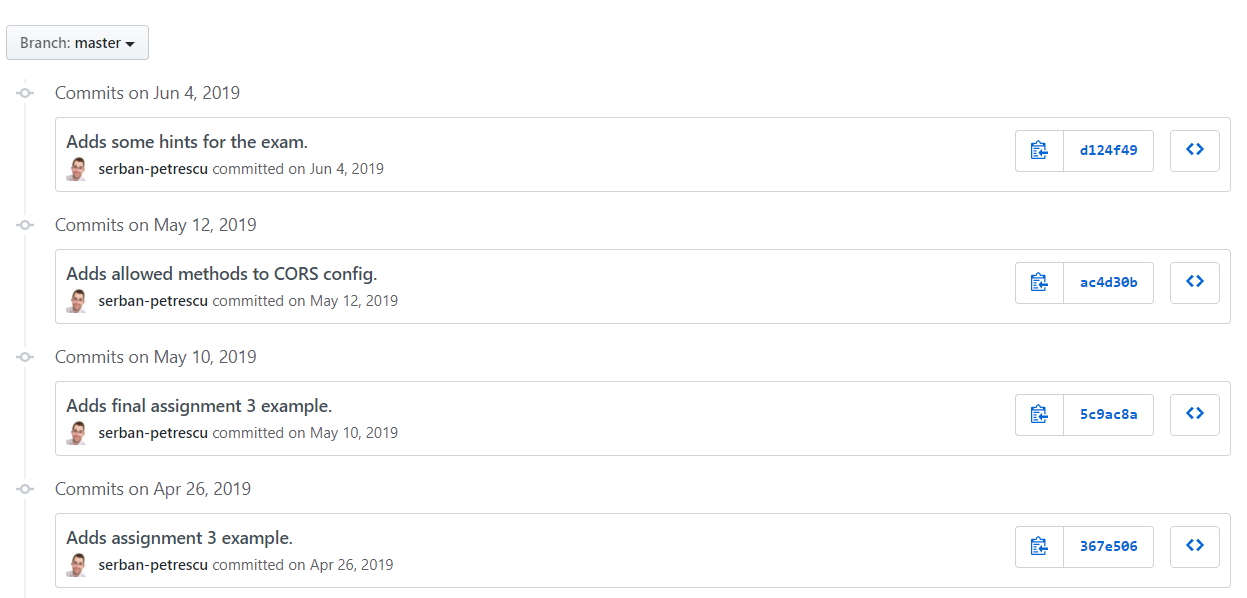Practical Dev. Guide
A hands-on Guide for build web apps
INtroduction
Foreword
About myself
- I have a BSc. in Computer Science from UT-CN,
- Currently studying for a MSc. in Software Engineering at UBB,
- Working as a Lead developer and solution architect,
- Teaching a Software Design laboratory at UT-CN,
- Trying to be active in open source and on Stack Overflow.
- UT-CN: Technical University of Cluj-Napoca. Website: https://www.utcluj.ro/
- UBB: Babeș-Bolyai University. Website: https://www.ubbcluj.ro/
- My portfolio: https://serban-petrescu.github.io/
AUdience
- Mainly intended for students searching for guidance in building software projects.
- May be useful for other entry-level developers.
- Prerequisites:
- Some programming knowledge (e.g. Java),
- Basic database design concepts.
Purpose
- Provide guidance for building modern web apps,
- Explain the most important concepts encountered,
- Explore and apply best-practices,
- Learn to leverage commonly-used tools.
Technologies
-
Frontend:
- React
- Ant Design
- Backend:
- Spring (Boot, Data, Security)
- Hibernate, Flyway
- Database: H2
- Message Queue: RabbitMQ
- Tools:
- IntelliJ IDEA,
- Postman,
- VSCode

Our practice app
Overview
- Throughout this series, we'll build a small school app.
- This app is used by teachers to:
- Import and maintain student data,
- Record attendance,
- Add grades,
- Generate a final report.
- It is also used by students to:
- View their own grades and attendance,
- Download a report card.
Student data
- At the beginning of the academic year, teachers receive spreadsheets with student data. For each student, the teachers get:
- Student identifier,
- Group number,
- First and last name,
- Email address.
- Each teacher imports this data and may later update it (in case something is inaccurate or outdated).
AttendAnce
- A teacher may teach several different topics, each topic requiring a series of lectures.
- During a lecture, the teacher records the attendance (the students which are present).
- The teacher may alter the attendance list - only during the day of the lecture - by:
- Removing a person (e.g. when kicking out someone),
- Adding a person (e.g. for appending late comers).
Grades
- For each topic, each student may receive a list of "tagged" grades (consisting of a name and a score). For example:
- The teacher adds grades for his students and may later edit these grades (but not remove).
| Tag | Score |
|---|---|
| Assignment 1 | 8.5 |
| Assignment 2 | 4 |
| Final Exam | 5 |
Final Report
- At the end of the semester, teachers submit a final report.
- This report contains the list of students with:
- A final score.
- An indicator with the status (passed / failed).
- In order to pass, students must obtain a minimum final score and must have a minimum number of attendances.
- Both these minimums and the formula for computing the final score from the grades are defined by the teacher.
Student view
- Students are notified via email when a teacher gives them a new grade.
- Additionally, students may view their own grades and attendance, grouped by topic.
- They may download this information as a report card.
Working mode
GitHub
- I'll use GitHub to share all the code.
- Each step will be a separate commit. You can checkout any specific commit in the history and try it out separately.

- GitHub Repository: https://github.com/serban-petrescu/practical-dev-guide
- GitHub Help: https://help.github.com/en/github/creating-cloning-and-archiving-repositories
Layered Architecture
- The application coding will be split into layers.
- Each layer will handle a single responsibility.
- With this architecture, it is easy to transition or include other styles / patterns (e.g. MVC).

VErtical vs Horizontal Slicing
- I'll develop the app using vertical slicing: one feature at a time.
- Horizontal slicing might be easier to follow in some cases, but it promotes a style of development that I don't recommend.
- More info on slicing https://beardedeagle.com/horizontal-slice-versus-vertical-slice/
